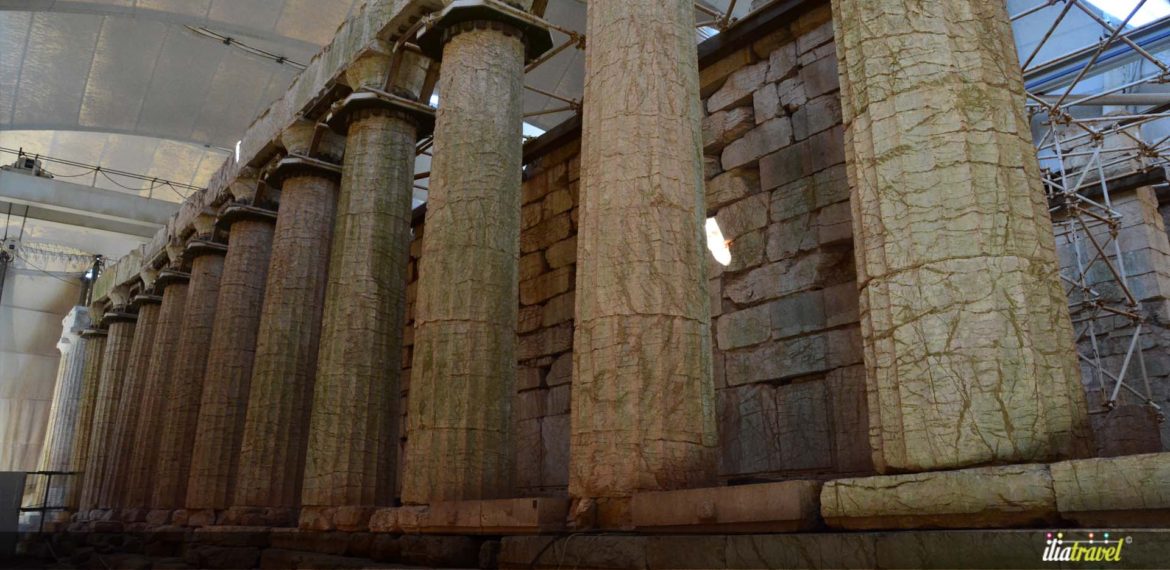DESCRIPTION
Southwest of Andritsena, in an imposing and wild mountainous landscape, is the magnificent Temple of Apollo Epikourios, one of the greatest temples of antiquity. The Temple is located 14 kilometers south of Andritsena, at an altitude of 1,130 meters above Mount Kolylo. In this place, which in the antiquity was called Vasses, the inhabitants of neighboring Figalia had founded since the 7th century BC. a sanctuary of Apollo Vassita, whom they worshiped with the name Epikourios as a supporter of war and disease. Indeed, it is said that the Temple of Apollo Epikourios was dedicated by the Phials to Apollo because it helped them overcome an epidemic of plague.According to the archaeologist, Olympia Vikatos, it is one of the most important and imposing temples of antiquity. It is characterized by numerous prototypes both in its exterior and interior design, making it a unique monument in the history of ancient Greek architecture. Pausanias, in fact, considers him the second to the Tegeo Peloponnesian Temple in beauty and harmony (8.41.8).Its erection dates back to 420-400 BC. and his architect is considered to be Iktinus, who in this creation succeeded in combining many archaic characteristics, imposed by the conservative religious tradition of the Arcadians, with the new features of the classical era. As it is also mentioned, the classic temple has been founded on the natural rock and is the only one that combines elements of the three architectural styles of antiquity. It is a Doric, a kiosk, a fist, with a pronaos, a sail, a sanctuary and an opisthodomos. Its form is more elongated, as in the archaic temples.
It is one of the best preserved monuments of classical antiquity. It is the best preserved temple after the Temple of Hephaestus in Athens, and it is the first monument in Greece that was included in the Unesco World Heritage Sites in 1986. The most important decorative element of the temple was the marble Ionic frieze that existed over the Ionic semi- inside the coat. It had a total length of 31 m and consisted of 23 marble slabs. In 12 of these, the Amazonomachy is depicted and in the remaining 11 Centaur. During the excavation of 1812 the slabs were found covered with architectural members in the vault and in 1815 they were moved to the British Museum where they are exposed today. Also, part of the sculptures of the frieze according to reports, decorate the showrooms of the Museum of Louvre and Munich. The sculptor of the frieze might have been Peonios, who painted in Olympia the famous statue of Victory.
Inside the Temple of Epicurius Apollo, there was a large bronze statue of Apollo, which, according to Pausanias’ testimonies when the great Polis was established, was transported and placed there in front of the mosque of Lykaios Zeus. Excavations and restoration interventions were initiated in 1902 by the Archaeological Society, while in 1975 the Temple of Apollo’s Assistant Temple Committee was established, which undertook the planning and preparation of relevant studies for conservation and restoration works. In 1982 the Ministry of Culture systematically undertook the extremely difficult task of restoring and preserving the monument. Since 1987, the temple has been protected from adverse weather conditions with a special roof, which will be removed after the completion of the necessary work.
| Period | Full Price | Reduced Price |
| 1/4 – 31/10 | 6€ | 3€ |
| 1/11-31/3 | 3€ | 3€ |
| Free Entrance | ||
| 6/3 | 18/4 | 18/5 |
| Last Weekend of September | 28/10 | Every first Sunday of months November to March |
| Closed | ||
| 1/1 | 25/3 | Good Friday 12.00-17.00 |
| 1/5 | Easter Sunday | 25/12 & 26/12 |
Video
Opening Hours
Location
Contact
- Address: Directions









There are no reviews yet.